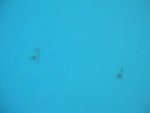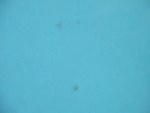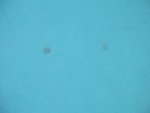Around the beginning of Q2 2015, I started noticing the appearance of small, white deposits on the bottom of my pool (see attached pictures). This is the first time I have encountered this issue in the 4 years I've owned this pool. It was only a few at first, then there was a large increase around mid-summer and the development of new ones seems to be tapering off now in cooler weather. Most of them were and still are located from the middle to shallow end of the pool and are usually surrounded by a brown stain. There are also some slag-like deposits on the walls of the pool, but they are far less numerous.
My research into this issue indicates that these are calcium nodules/slag. Initially, I thought we had a build-up of calcium and a PH problem in the pool from over-shocking, but several checks of the chemical balance by my pool service and a local pool supply store have shown no issues with the pool chemistry. My pool service indicated that this might be due to a form of "efflorescence," whereby the concrete is leaching various minerals through the plaster. My research also suggests this might be the beginning of delamination of the plaster from the concrete (time to re-plaster). The plaster is probably between 10 and 15 years old, but I don't have a good record of it.
The nodules are very stubborn. They have not responded to regular brushing or chemicals (in this case, Scaletec). I'm at a loss for what to do except wait for warmer weather and try to remove them with pumice stone or sandpaper. Based on the pictures, I'd appreciate anyone's insight on the subject. What, if anything, can I do about the nodules and stains? Is it simply a lost cause and time to re-plaster?
My personal belief is that some porosity or damager occurred to the plaster when I drained the pool back in the fall of 2013 in light of a buildup of cyanuric acid. Coincidentally, the nodules are located primarily in the areas where the plaster dried out prior to re-filling (shallow end and walls). That, along with some sort of natural phenomenon in the concrete, is what I believe has led to the current issue. Your thoughts?
My research into this issue indicates that these are calcium nodules/slag. Initially, I thought we had a build-up of calcium and a PH problem in the pool from over-shocking, but several checks of the chemical balance by my pool service and a local pool supply store have shown no issues with the pool chemistry. My pool service indicated that this might be due to a form of "efflorescence," whereby the concrete is leaching various minerals through the plaster. My research also suggests this might be the beginning of delamination of the plaster from the concrete (time to re-plaster). The plaster is probably between 10 and 15 years old, but I don't have a good record of it.
The nodules are very stubborn. They have not responded to regular brushing or chemicals (in this case, Scaletec). I'm at a loss for what to do except wait for warmer weather and try to remove them with pumice stone or sandpaper. Based on the pictures, I'd appreciate anyone's insight on the subject. What, if anything, can I do about the nodules and stains? Is it simply a lost cause and time to re-plaster?
My personal belief is that some porosity or damager occurred to the plaster when I drained the pool back in the fall of 2013 in light of a buildup of cyanuric acid. Coincidentally, the nodules are located primarily in the areas where the plaster dried out prior to re-filling (shallow end and walls). That, along with some sort of natural phenomenon in the concrete, is what I believe has led to the current issue. Your thoughts?






